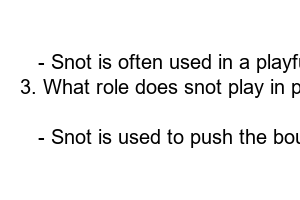코딱지가 자주 생기는 이유
**Why Snot Often Occurs in English: Exploring the Common Occurrence**
Have you ever wondered why snot seems to be such a common occurrence in the English language? From everyday conversations to written texts, it’s hard to escape this sticky subject. Let’s delve into why snot pops up so frequently in the English language.
**1. Snot as a Descriptive Term**
Snot is often used in English as a descriptive term to convey disgust or disdain, making it a versatile word in expressing emotions. It provides a vivid image that easily captures the intended message without mincing words.
**2. Snot for Humorous Effect**
In many cases, snot is used in a humorous context to elicit laughs or lighten the mood. This playful use of the word adds a touch of irreverence to everyday language, making it more engaging and relatable.
**3. Snot as a Symbol of Discomfort**
When snot makes an appearance in English, it is often used to symbolize discomfort or unease. Whether it’s a physical sensation or an emotional response, snot serves as a powerful symbol that resonates with many people.
**4. Snot for Graphic Detail**
Snot is also commonly used in English to provide graphic detail or imagery in descriptions. Its visceral nature helps paint a vivid picture in the reader’s mind, adding depth and realism to the text.
**5. Snot as an Expression of Authenticity**
Many writers and speakers use snot in English as a way to inject their language with a sense of authenticity and rawness. By embracing the messy and unfiltered aspects of snot, they create a more genuine and relatable connection with their audience.
**6. Snot for Shock Value**
Lastly, snot is sometimes used in English for shock value, pushing the boundaries of social norms and expectations. This bold choice can grab attention and provoke thought, challenging conventional ways of communication.
In conclusion, snot’s frequent occurrence in English can be attributed to its versatility, humor, symbolism, graphic detail, authenticity, and shock value. By understanding the various roles that snot plays in language, we can appreciate its richness and complexity in our everyday communication.
**Summary:**
Snot is a common occurrence in the English language, used for its versatility, humor, symbolism, graphic detail, authenticity, and shock value. Its presence adds depth and dimension to language, making it more engaging and relatable to a wide audience.
**FAQs:**
1. Why is snot considered a versatile term in English?
– Snot can be used to convey emotions, add humor, provide graphic detail, symbolize discomfort, and create authenticity in language.
2. How does snot contribute to humor in English?
– Snot is often used in a playful and irreverent way to elicit laughter and lighten the mood in conversations and texts.
3. What role does snot play in providing graphic detail in language?
– Snot helps paint vivid imagery and descriptions, adding depth and realism to written and spoken language.
4. Why is snot sometimes used for shock value in English?
– Snot is used to push the boundaries of social norms and provoke thought, challenging conventional ways of communication.

